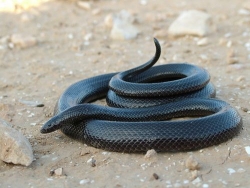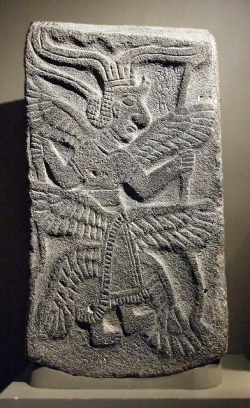ùÒÈøÈó, pl. ùÒÀøÈôÄéí
 |
A raging, consuming, tower of fire, advancing like a living being; corrupted to "seraphim". The combinative form is "…ùÒÀøÈó" (sᵊraphꞋ …; a consuming tower of fire of…).
ùÒÀøÈôÄéí in
"A basalt relief from [Tel Khalaph, Iraq] shows a composite deity with three pairs of wings, holding a snake in each hand. This figure resembles the seraphim of [
 |
ùÒÀøÈó äÇòÅéï âÆÌãÄé(Atractaspis engaddensis) |
Also the name of a snake, known variously as the mole viper, öÄôÀòÉåï or öÄôÀòÉåï ùÑÈçåÉø, burrowing asp, stiletto snake, side-stabbing snake (see close-up below, showing side fang that makes this snake impossible to handle with normal means), and Father of Death. The scientific nomenclature, Atractaspis engaddensis, derives from yet another of its names: ùÒÀøÈó äÇòÅéï âÆÌãÄé; (scienceblogs).
An unidentified snake expert at a snake park, upon identifying this species of viper, reported to a bite victim: "It's a Stiletto snake aka Burrowing Asp. Highly venomous, a Cytotoxic poison, no anti-venom—but don't worry, you won't die…" Another bite victim reported: the bite site turned immediately navy blue and an intense burning sensation started. If any breeze even slightly touches your arm the burning sensation intensifies extremely… The swelling immediately starts at the bite site. The glands and dry mouth hang around for about 12 hours. On the 2nd day the burning sensation subsides. The swelling and headache persist for 3 days. On the 4th day the swelling starts going down. By the 5th day the swelling is down a lot but the bitten finger took about 3 months before I could bend it normally again. Problems with the bite site persist for at least 6-8 months after the bite.
 |
ùÒÀøÈó äÇòÅéï âÆÌãÄé(Atractaspis engaddensis) |
This fits with the description of making the trek to gaze at the ðÀçÇù äÇðÌÀçÉùÑÆú (
Also, by allusion to its "raging fiery venom," the Atractaspis engaddensis is called the "ùÒÀøÈó äÇòÅéï âÆÌãÄé, as well as "burrowing viper," "mole viper" or "stiletto snake" – "Highly venomous, a Cytotoxic poison, no anti-venom - but don't worry, you won't die…" (scienceblogs.com).
Its fangs protrude from the sides of its mouth, striking sideways by swinging its head to the sides. This makes this viper so dangerous that not even the most experienced snake handlers dare handle this snake in a conventional manner. Researchers needing venom to study must first use tongs to manipulate the viper into a custom-fitted glass tube, so that only its head protrudes and it cannot swing its head in any direction, before they can safely handle this snake—more accurately, handling the tail of the snake, (to keep it in place in the tube) and handling the tube to milk its fangs for venom.
Google+ registered author-publisher


